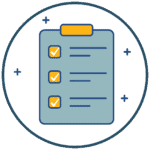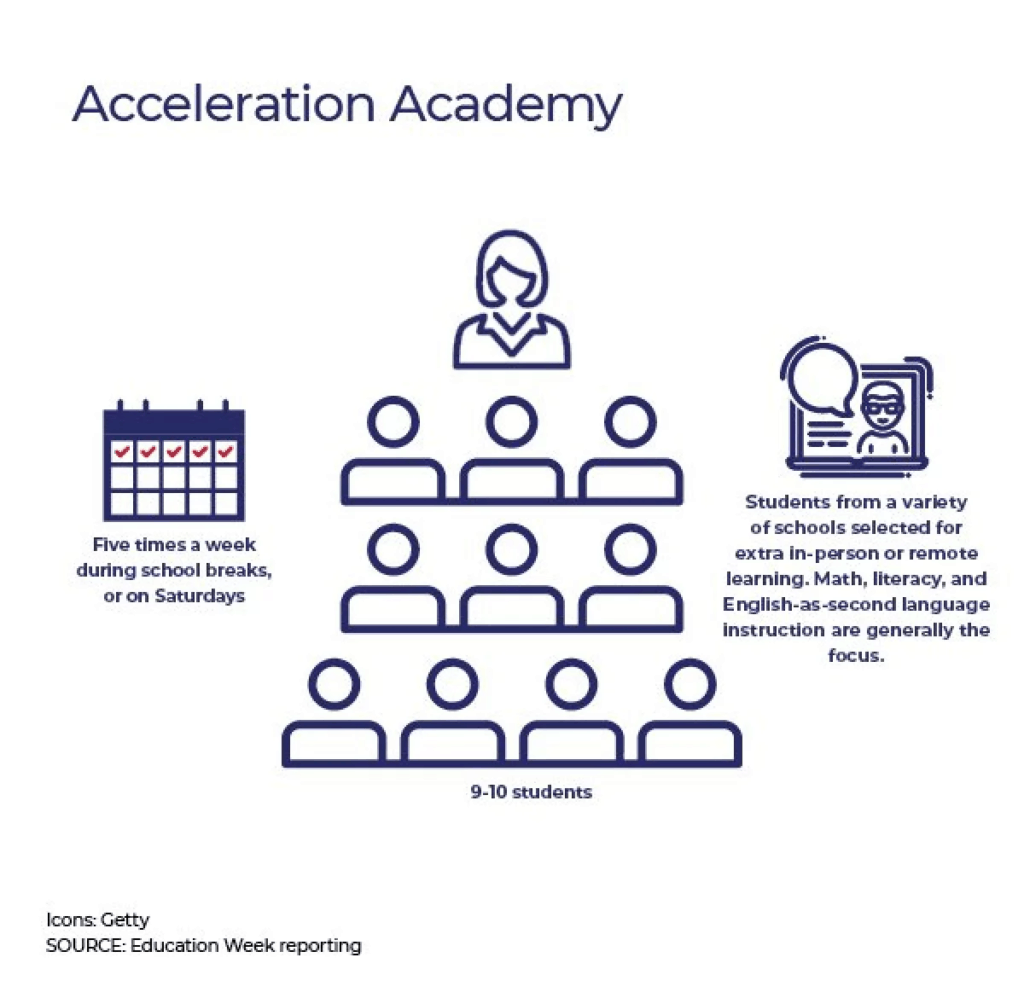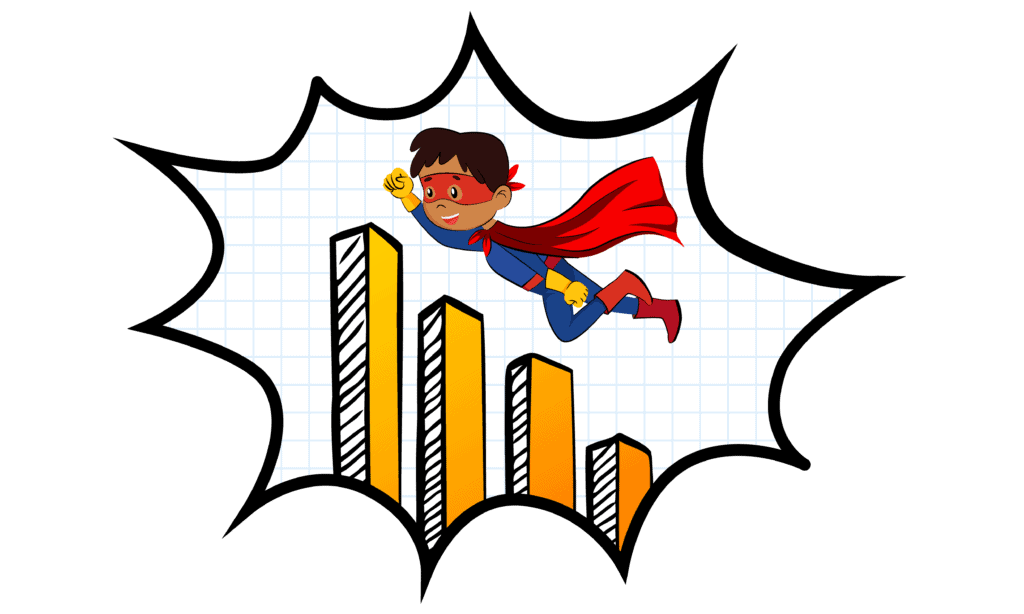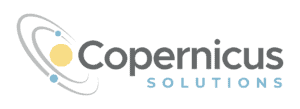MODELS TO INSPIRE
What models can be used to accelerate learning?

KEY TAKEAWAYS
- There are different ways of accelerating learning. There are multiple ways to accelerate learning but not all have the same impact.
- You can do more than one. Different models can be implemented together if they fit in your learning acceleration vision.
- High expectations and grade-level content are key. The most important aspects of any learning acceleration model are high expectations and grade-level content. More specifically, 75% of instruction should be at grade level (25% remedial, if you need to build a bridge), and 100% of what you assign and assess should be at grade level.
- Align your vision to how you allocate your time. Alignment is necessary for any model to work. Your model should align to your values and must be integrated into your strategic plan, school vision, and particularly schedule. For example, do you have a structured intervention block?
CURATED TIPS
- Ensure that your school’s systems match your strategy. Your strategy will only work as well as your systems. Do you have a structured intervention block? Do you have a vertical alignment meeting structure set up for your teachers? Do you have a system for reporting and monitoring student performance on the standards you’ve prioritized? Your schools will need these systems and more to ensure that students master grade-level standards this year.
- Whole-group remediation vs. targeted intervention. As you pick a model to implement, consider when to leverage whole-group remediation to address learning gaps and when targeted intervention may make more sense. It is crucial not to make assumptions about where all students are. Instead, use data to make strategic decisions about students’ needs. Some classrooms may need whole-group remediation on content from the previous grade. For example, if an entire second-grade class is missing the spellings for /r/-controlled vowel sounds, that teacher may need to build in practice opportunities for students to build their automaticity with this particular reading foundational skill. However, if it’s a small portion of the class, using your intervention block to serve those students will be a better approach. Depending on what schools have been using for intervention, you may need to retool the content of your intervention block to be more aligned to specific learning gaps and content from the previous grade.
- External partners will require extra prepping. Using external folks will take intentional training and time for ongoing check-ins. Regardless of how you leverage outside partners and families, providing them insights about what students should know and explaining your approach to accelerating learning is always wise.
- External partners won’t be the silver bullet. Don’t bank on external partners being able to do it all, but do leverage your partners for additional support. Acceleration is directly tied to grade-level content. If partners are not aware of or aligned to grade-level instruction and assignments, they will not help you accelerate learning.

Click to expand the menu below and explore the different learning acceleration models.
Blended learning is an approach to learning that combines online curriculum and opportunities for interaction online with traditional place-based classroom methods. It requires the presence of both teacher and student, with some elements of student control over time, place, path, or place.
There are several models of blended learning; for learning acceleration, station rotations and individual playlists are some of the most effective practices. They both provide time to use small-group or individual intervention and time to personalize instruction to students’ needs.
To set up a blended learning program, consider:
- Blended Learning Universe as a tool to design your blended program
- The Learning Accelerator’s collection of nearly 100 strategies for implementing student-centered instructional approaches for each student based on specific strengths, needs, interests, and goals
- The Aurora Institute’s guide to Getting Started with Personalized Learning (resources for education leaders, teachers, and policymakers looking to redesign K-12 education around student learning with personalized learning and competency education)
- LEAP Innovations’ personalized learning tools and resources
- The Learning Accelerator’s resources on subject-based “playlists” to enable self-paced subject learning, including customized versions and playlist data trackers
- Flipped learning: In flipped learning, students watch the video lesson and learn the material at home, then come to school and have class time to work on problems where the teacher and fellow students are available to answer questions.
Helpful Samples
- Sample blended rotation by Blended Learning Universe
- Sample playlist
- A rubric by Thrive to reflect on and assess classroom practices by focusing on specific strands and examples of mastery
Featured Resource: A conversation about hybrid learning with Catlin Tucker and Tom Armelino
Real-World Examples:
- Lindsay High School, which serves all grade 9-12 students in Lindsay Unified Public Schools, implemented blended learning in a diverse rural district school with a large population of free and reduced lunch students. The model focuses on high school English and English language learner classes. Core strategies include the implementation of a performance-based system, the ability for students to work across grade levels, customized playlists for learners, learner choice throughout their day/week/year, individual personalized learning time, and a focus on lifelong learning standards (non-cognitive skills). You can read more about their work here.
- The Byron School District in Minnesota embraced a flipped-learning model for high school that also included study groups. This addresses the typical math classroom problem: students passively listen to the lecture, begin the homework (only getting to the easy ones), go home and get stuck. Instead, students are able to tackle the “difficult” part of the learning—the problems—in the classroom, where there is immediate help available from the teacher and peers. As a result, the district has seen student engagement and success increase significantly from traditional learning. Its math department offers tools and supports from teachers for teachers here.
- Valor Collegiate in Tennessee individualizes math practice through self-directed and self-paced online playlists, housed in Google Docs. Each playlist is focused on a grade-level math standard, allowing students to self-select a targeted playlist based on their individual needs.
- Cisco Independent School District district uses an individualized assignment chart that students work through at their own pace. You can read more about this type of playlist here.
Tutoring is a form of teaching, one-on-one or in a small group, toward a specific goal. These can happen as part of the school day or even outside of school hours. By responding to individual needs and complementing existing curriculum, high-impact tutoring leads to substantial learning gains for students by supplementing (but not replacing) students’ classroom experiences.
According to research and an article from LPI, effective tutoring includes:
- Employing current or former classroom teachers when available, or using other paid staff such as paraprofessionals, teacher candidates enrolled in preparation programs, or well-trained tutors who earn a stipend, such as AmeriCorps members;
- Providing at least 3 days per week for at least 30 minutes, as part of the regular school day, in groups of 5 or fewer;
- Personalizing the experience to students’ needs as well as current grade-level and class work;
- Offering tutors access to high-quality curriculum and clear implementation guidance;
- Investing in staff capacity building by providing quality training (10 hours, in the best programs, on content and facilitation skills) and ongoing support;
- Building relationships among students, tutors, and teachers through structured time that is well-aligned with regular classroom curriculum. Positive social connections between students and their tutors that promote engagement with educational content and increased motivation.
Resources
- FEATURED RESOURCE: Video primer on implementing a high impact tutoring program by National Student Support Accelerator in partnership with CCEE.
- More research can be found in this article by LPI about why we should aim for reinvention.
- Considerations for funding and extensive tips and tools are in this tutoring playbook from FutureEd at Georgetown.
- A guide to designing an evidence-based tutoring program from JPAL
- EdSearch’s framework for using high-dosage tutoring to accelerating learning includes examples of effective tutoring models.
Real-World Examples
The Los Angeles United School District is paying teachers to serve as outside-of-school tutors providing individualized support to students. In first grade, this work is part of Primary Promise, a program aimed at closing early literacy gaps. Students receive intensive support in small groups during or after school, for a minimum of 10 weeks. You can read more here.
The Tennessee Tutoring Corps is using tutoring to help accelerate learning during Covid-19. The goal is to recruit at least 1,000 qualified college tutors eager to give back to their communities and help prevent summer learning loss among the most vulnerable students.
 The burst of time model aims to provide extra learning time in smaller groups without taking away from core instruction during the school day. Often, this instruction takes place during breaks and on weekends with qualified teachers using targeted instruction.
The burst of time model aims to provide extra learning time in smaller groups without taking away from core instruction during the school day. Often, this instruction takes place during breaks and on weekends with qualified teachers using targeted instruction.
Real-World Examples
- Acceleration Academies used this approach during winter and spring break weeks in Lawrence, Massachusetts. In these academies, teachers work with students in small groups on hands-on learning that brings them back to school with strong skills and confidence. You can read more about this program here.
- Cajon Valley Union School District created Power Hour, a schoolwide reading intervention and support program that included 30 minutes of schoolwide reading and 30 minutes of home-based reading. This accountability-based, personalized learning and reading approach ensures all students have time and support for reading learning-level and grade-level texts.
This model can only be successful when supported and front-loaded by strong intentional educators. Learning independently can be challenging, even for the brightest and most motivated students. However, it has never been more important to develop this ability than today. The ability to be a self-directed learner has been a major differentiator of success in distance learning, highlighting the need to develop skills like goal-setting, researching, progress monitoring, self-management, and communication, to name a few. Read this report by the Learning Accelerator for more information and look in CCEE’s Field Guide for more info about developing student agency.
- Have clear expectations and learning goals. Design expectations and goals with the team and communicate them clearly to students and parents. Here are some strategies to help.
- Create a system approach. Systems like study groups, office hours, and independent learning plans can be great additional support, but to make them effective, consider these steps:
- Explicitly teach systems and norms. Learners need to be explicitly taught self-direction and how to navigate their own learning, especially once they finish a task and are ready for the next.
- Design the day for self-directed work. For example, create maker spaces, “genius hours” when students can have access to experts, or independent study courses to encourage students’ self-direction. Particularly during remote learning scenarios, learners need tools, routines, and resources to be independent learners.
- Design guardrails.
- For students: create organization wide guides, supports, and cues to help remind students of goals, procedure, priorities, logistics, and choices.
- For families and CBOs: Create school wide policies and structures for study groups or office hours so that parents, CBOs, and others can point students consistently to structures that can support them.
- Simplify routines. Reduce cognitive load for navigating tools. Simplifying what needs to be done and making it less overwhelming goes a long way to helping increase comprehension and performance.
- Combine with blended learning. Couple this with blended learning to allow students some ability to co-create path, pace, and place. Blended learning can be extremely effective when done well, creating more opportunities for targeted instruction and practice of skills, concepts, or ideas that students can work on independently.
Real-World Examples
- Students at Cisco Junior High School can choose from a variety of different options for working with other students. For the most part, students have autonomy in choosing whether they want to work independently, with a partner, or in a group. This autonomy extends to choosing their partners and group members as well. Sometimes teachers intervene, however, when students are not making good choices of partner or group.
- The Da Vinci Connect High School uses office hours and study groups to accelerate learning.
- Office hours are intended to engage students in a small-group or one-on-one student-teacher ratio. This allows students to participate more freely and openly with the teacher. It is also an opportunity for students and teachers to get to know each other.
- Study groups are based on research from Jo Boalar, consist of 3-4 students, and help expose students to different perspectives on any given subject. Students are able to learn by seeing different ways of approaching a problem. Study groups can be organized in the classroom with an assigned classroom task. Often these groups will organize to meet outside of school to complete a project or to study for an exam.
The concept of a community-based model is to identify ways to partner with community-based organizations (CBOs) and leverage assets in the community to support student learning. Community-based support for learning acceleration exists in various forms, ranging from community school models to learning hubs around town (e.g. community hubs in San Francisco) and leveraging after-school partners. Community schools tend to receive funding and resources to operate a model that fully integrates with CBOs, but it’s okay if you don’t have the capacity to execute a community school model. There are still other ways to leverage partnerships with CBOs to support learning acceleration.
The most critical thing is to create academic alignment and offer training to ensure that students are getting not just supervision, but high-quality aligned academic support. Ensure that you and your CBO partner are aligned on vision and learning outcomes and are communicating regularly to best support student learning. You can see more about how to engage CBOs here.
Real-World Examples
- San Francisco Community Hub Initiative is a citywide, neighborhood-based strategy to support children, youth, and families during the school year. Community hubs provide support for students in grades K-12 who are utilizing SFUSD’s distance learning curriculum, prioritizing children and youth with high levels of need.
Encouraging family engagement in learning is more than common courtesy. In addition to building student agency, families can also play a critical role in supporting learning acceleration when they are informed of what children should know and be able to do. Families became an integral part of the learning day during the pandemic and LEAs can leverage these relationships to further accelerate student learning while at home; it’s one of the best ways to support student success.
Given the technology and curriculum investments many schools have made last year, there are opportunities for students to work at their learning level and grade level effectively at home through the use of technology. You can visit the family engagement section for more tips, but some schools have used their blended learning work (especially strategies such as flipped homework and personalized playlists) to leverage the work that students are doing at home.
This work starts with ensuring 100% of teachers connect with families and that communication with guardians includes what children should know and be able to do, and offers training and resources.
Resources LEAs Can Use with Families
- Consider these family-friendly grade-level learning overviews from Seek Common Ground and roadmap to common core for parents from the Council of the Great City Schools (also available in Spanish).
- Sites like Be A Learning Hero offer activities and tools for families; Clave al Éxito (Key to Success) helps Spanish-speaking parents engage in their children’s education.
- Schools and families should encourage study groups as a great way to share learning. College Raptor offers tips on how to create an effective study group.
Real-World Examples
- Humboldt Elementary is sharing data with parents and helping them understand it. Understanding academic data can be a powerful way to engage and leverage families to accelerate learning.



